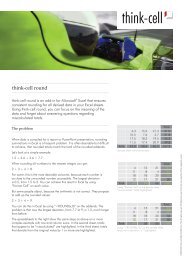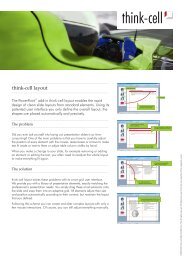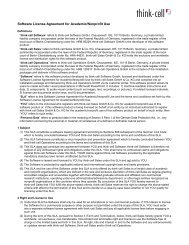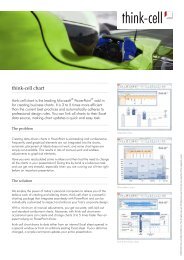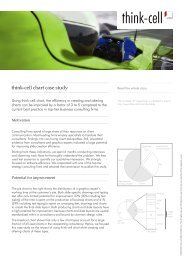think-cell technical report TC2003/01 A GUI-based Interaction ...
think-cell technical report TC2003/01 A GUI-based Interaction ...
think-cell technical report TC2003/01 A GUI-based Interaction ...
Create successful ePaper yourself
Turn your PDF publications into a flip-book with our unique Google optimized e-Paper software.
5.2 An Application of Dynamic Programming IMPLEMENTATION<br />
5.2.3 Finding the Optimal Solution in Polynomial Time<br />
The analysis of the recursive algorithm reveals that the local costs for each node<br />
are calculated up to three times. Also, the graph in figure 42 has a rectangular<br />
structure, suggesting that the results of the cost calculations could be cached in a<br />
regular matrix. This is precisely what the dynamic programming technique describes<br />
(see Fig. 44): A matrix is filled with cumulated minimal costs and then the optimal<br />
solution is reconstructed from the matrix. To make the reconstruction possible, not<br />
only costs must be stored in the matrix, but also the locally optimal decisions.<br />
The respective algorithm is presented in figure 45. The iterative implementation<br />
of the MergeGridlines() function has the same interface (input and output) as<br />
the recursive variant. However, it runs in polynomial time: The loop body is<br />
executed m + n(m + 1) times, where m and n are the numbers of destination and<br />
source gridlines in the input. Again, I assume the cost function to be of polynomial<br />
time complexity. Thus, the asymptotic running time for the dynamic programming<br />
algorithm is Θ(nm) or Θ(n 2 ), if we assume n and m to be of the same order.<br />
In this case, the cost function is called CostPrev(), because it calculates the costs<br />
for a decision that has already been made to reach the current state. The algorithm<br />
then stores only the decision that has minimal cumulated cost and disregards the<br />
other ones.<br />
Once the matrix is filled, the bottom right corner reflects the total costs of the<br />
optimal path, which can now be reconstructed by following the matching decision<br />
annotations. The reconstruction of the optimal path is trivial and takes linear<br />
time 15 , thus not contributing to the over-all asymptotic running time of the algo-<br />
rithm.<br />
Dest.<br />
Source<br />
1<br />
2<br />
3<br />
4<br />
5<br />
Solution<br />
1 2 3 4 5 6<br />
0<br />
SOURCE<br />
7<br />
SOURCE<br />
11<br />
SOURCE<br />
26<br />
SOURCE<br />
58<br />
DEST<br />
20<br />
SOURCE DEST IDENTIFY IDENTIFY DEST DEST<br />
96 131 81 97 105 139<br />
Solution<br />
DEST DEST DEST DEST DEST<br />
23 77 165 317 428<br />
SOURCE IDENTIFY DEST DEST IDENTIFY DEST<br />
29 31 46 59 178 210<br />
DEST SOURCE DEST SOURCE IDENTIFY IDENTIFY<br />
18 35 41 61 74 199<br />
SOURCE DEST IDENTIFY SOURCE SOURCE DEST<br />
24 29 55 79 115 171<br />
SOURCE SOURCE DEST IDENTIFY DEST DEST<br />
70 89 133 83 109 147<br />
IDENTIFY<br />
134<br />
Figure 44: Dynamic programming cost matrix with optimal path reconstruction,<br />
comp. Figs. 41 and 42<br />
15 The asymptotic running time for optimal path reconstruction is O(n + m), because in each<br />
run of the while loop either i or j or both are decreased.<br />
80





